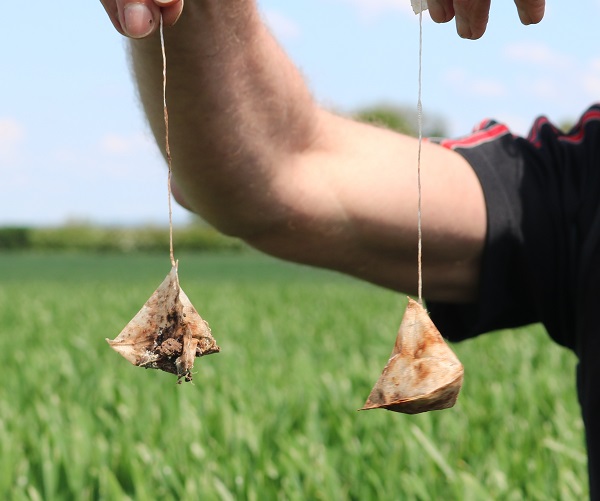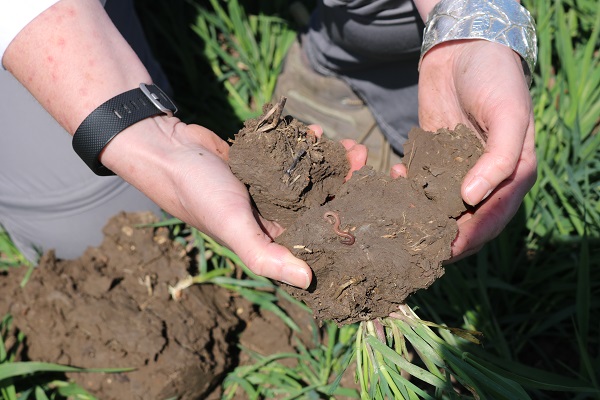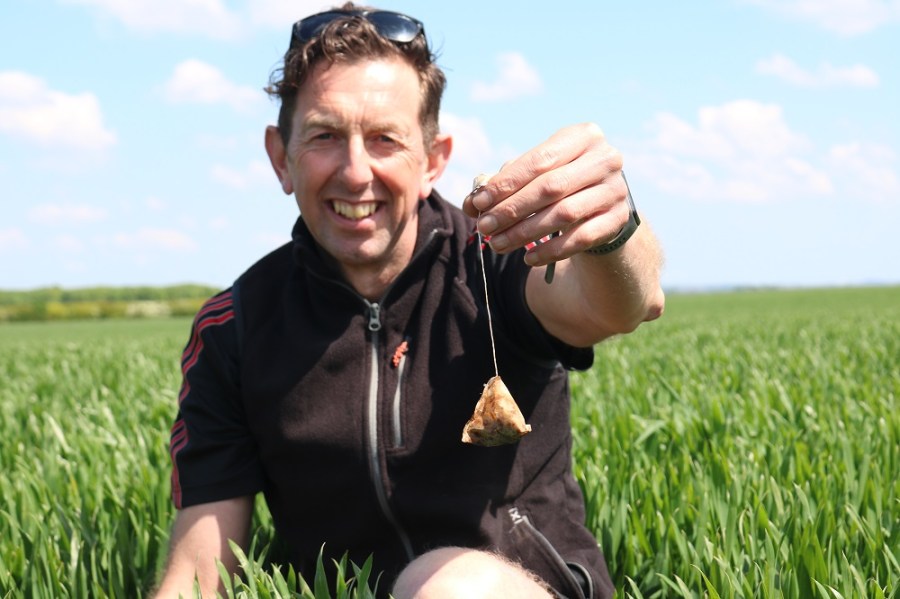An innovative approach to measuring soil health is being put to the test by a N Lincs farmer. CPM joined a tour of his fields, organised by BASF.
Time since tillage often determines soil health.
By Tom Allen-Stevens
Pat Thornton offers us all a cup of tea, and there’s a note of caution before accepting. Barely 30mins earlier we saw him extract two teabags that had been buried in the middle of one his fields as part of a global research project into soil properties.
“Today is T-day,” he announces. “On 16 Feb I buried two teabags in each of two fields and today is the day to dig them up and weigh them. It’s to measure the decomposition rate of my soil.”

The Green tea (left) indicates stabilisation while the Rooibos tea allows the rate of decomposition to be deduced.
It’s part of a tour to explore the soils of Pat’s 142ha Lower Melwood Farm near Doncaster, N Lincs. The farm lies on heavy silty clay loam close to the River Trent, but not close enough to benefit from the warp land created centuries ago when land near the river was deliberately flooded to produce deep, fertile silt soils.
“We look on in envy at that land. Drainage dictates how we farm, and water only moves when you tell it. We’ve land that’s broken ploughs in the past,” recalls Pat. It’s also the site of an old Carthusian monastery, and alongside its more tricky soils there’s permanent pasture that hasn’t even seen a plough since the monastery was dissolved during the reign of King Henry VIII.
The resulting huge variance in his soil properties is something that’s always fascinated Pat. As one of the BASF Real Results farmers, it’s an interest he’s found he shares with a number of others, so he’s set about involving around 20 of them in the “Dirt-tea sods” campaign. This feeds data from their soils into the Tea Bag Index (TBI), a global network run by young researchers from the Netherlands and Austria..
“A number of us did the #soilmyundies thing, where we buried underpants to see how they decomposed – quite a visual demonstration,” he says. “But some of us who are into reduced tillage wanted to know if we were making our land any better. That’s when I came across TBI.”

Worms and roots struggle in this compacted soil that’s been in arable crops for over 60 years (left), while fields that were in grass 20 years ago have the texture of chocolate cake (centre) and permanent pasture is perfect (right).
The project was started in 2010 by a group of Dutch and Finnish researchers who were looking for a way to measure soil decomposition. The difficulty was to find standardised litter bags that would be easily available on a global scale, recalls Dr Taru Sandén, now at the Austrian Agency for Health and Food Safety. “Dr Judith Sarneel and Dr Joost Keuskamp from the TBI team were discussing it over a cup of tea, and we suddenly struck on the idea of using teabags,” she says.
It took some time to determine the type of tea to use and refine the methodology. “The advantage of tea is that it’s a consistent plant material, distributed globally. The products we settled on were Lipton Green tea and Rooibos tea.”
When buried, Green tea decomposes fast, as it’s comprised of material soil microbes find relatively easy to break down. Rooibos tea decomposes more slowly and is generally still in that first stage of decomposition after 90 days. From data on weight loss of the two samples, researchers can determine the stabilisation factor (S) and rate of decomposition (k) for the soil.
“k indicates the rate by which the labile fraction of the tea is decomposed. This is important for farmers as it indicates available nutrients released to the plants. But it’s also important to know how much plant material stays in the soil, rather than being released as CO₂. S can be interpreted as the degree to which the labile fraction of the tea remains after three months of incubation,” explains Taru.
She recommends farmers use TBI in conjunction with soil analyses measures of organic matter (SOM), texture and plant-available nutrients to help assess microbial activity. “Work in Sweden and Austria suggests you can measure the effect of different tillage methods with these factors. Roller crimping, rather than conventional tillage, results in higher stabilisation factors, for example.”
In the UK, Dr Sarah Duddigan has done most work with TBI, using it for a citizen science project, funded by Defra, BBSRC and the Royal Horticultural Society. “450 people signed up and took measurements in various places in their garden,” she reports.
“What was most interesting was the relationship between SOM and composting rate. In most areas, the more SOM, the faster the rate of decomposition. But this also depends on the carbon fraction, and the carbon/nitrogen ratio of plant material – microbes are less active where there’s more woody material.”
While relatively few UK farmers have measured their TBI, she recommends finding up to three contrasting areas within a farm and conducting a comparison. “You’re not necessarily looking for high or low S and k values, but the relationship between them, depending on your priorities,” she says.
Pat has his results back. The winter wheat field that includes his Real Results trial has a k of 0.009 and S of 0.358. Just next door, in Nov-drilled spring wheat following cover crops, k is 0.008 and S is 0.416. A soil analysis of the Real Results field gives it a high rating for soil health and microbial activity with a SOM of 3.2%.
“Around 20 years ago this land was in grass or grass rotation and we’ve tried to look after it since, direct drilling where we can. This shows it’s relatively healthy, and it may be that where we had cover crops we’re sequestering slightly more carbon.”
Independent soil scientist Prof Jenni Dungait has joined the tour of Pat’s farm and carries out a visual assessment of the soils in these fields. “You can tell there’s plenty of SOM, the spade goes in easily and the soil looks like chocolate cake – there’s a good friable structure through the topsoil, although the aggregates are a little more angular below plough depth.”
Pat then takes the group to a nearby field that’s been in an arable rotation for over 60 years, currently in spring barley, and Jenni struggles to get the spade into the soil. “There’s evidence of compaction at the surface and right through the topsoil, with soil breaking off in sharp, angular plates. Roots and earthworms have struggled to get through this structure. It needs some help from remedial cultivations before a direct-drilling regime will do any good,” says Jenni.
But top marks go to the permanent pasture, not turned for over 500 years. “Time since tillage often determines soil health and the structure of this soil is just about perfect for this soil type. When gauging soil health, rather than comparing with other farms, it’s worth finding a field like this as the ultimate healthy soil you can achieve on your farm,” she concludes.
- For more information on TBI, go to teatime4science.org
New product addresses Government clampdown on ammonia emissions
Limus, BASF’s new urease inhibitor, reduces ammonia emissions from urea fertiliser by up to 98%, delivering a similar yield performance to ammonium nitrate fertiliser, says product manager Jane Kitchen.
“The Government’s Clean Air Strategy, published earlier this year, seeks to legislate to control ammonia emissions from agriculture, which account for 88% of the total,” she notes. “About a quarter of that comes from manufactured fertilisers, and one of the proposals to address this is to introduce a requirement to spread urea-based fertilisers in conjunction with urease inhibitors.”
Urease enzymes occur naturally in the soil and convert urea into ammonium. This temporarily raises the pH of the soil around the urea, and if there isn’t sufficient rainfall to buffer the pH spike, this results in volatilisation, where the urea is lost as ammonia gas. “Urease inhibitors block the enzymes, slowing down this conversion and so reducing volatilisation,” she explains.
Limus is the only urease inhibitor available that contains two active ingredients. N-(n-butyl) thiophosphoric triamide (NBPT) is a generic inhibitor while NPPT is a new molecule from BASF. This combination is claimed to be more effective on the range of enzymes than single-active alternatives.
“What’s also unique about Limus is that the formulation contains BASF’s polymer technology, which provides longer active ingredient stability compared with generic alternatives. It also has a longer shelf life lasting for more than 12 months, even at 20°C,” adds Jane.
Trials carried out by ADAS have shown Limus-treated urea delivers on average a 5% yield advantage in winter wheat over untreated urea, and similar results to AN. It’s a liquid formulation applied to urea prills before it’s supplied to farm, available only through Thomas Bell, Bartholomews and COFCO.
“We have a liquid product that does the same job, added to UAN and UAN+S fertilisers,” continues Jane. “This is added directly into the tank at the time of application, a bit like AdBlue for diesel.”
Xarvio complements chemistry with algorithms and machine learning
BASF has started rolling out its digital suite of tools, set to offer an extra layer of precision to arable farmers. The xarvio range of solutions was developed originally by Bayer, but divested by the company following its acquisition of Monsanto.
“We’re pleased to have xarvio on board,” says Louis Wells, BASF UK solutions and services manager. “Our over-arching objective is to make farming more precise, and xarvio aims to bring that to a cm² level within the field.”
Two tools in particular are available – xarvio Scouting has been launched and offers identification for a range of weeds, pests, diseases and other crop properties through your smartphone. xarvio Field Manager is a decision support tool that tailors agronomic advice to your crop conditions, which is currently undergoing evaluation and will be launched in the UK in 2020, says Louis.
Dubbed “the assistant in your pocket”, xarvio Scouting detects in-field stress from photos you upload through an app, available for free for both iOS and Android phones. There are five tools to which you can beam your problem photos:
- Weed Identification can currently identify 117 different broadleaf weeds, while the aim is to build this to 800. Within seconds the app will feed back which weed it is with a percentage confidence rating.
- Yellow Trap Analysis will assess the contents of a standard in-field water trap and can tell the difference between cabbage stem flea beetle, seed weevil and pollen beetle, for example, giving you numbers found of each.
- Disease Recognition identifies most diseases in wheat and barley, although not yet rhynchosporium.
- Nitrogen Status includes elements ofYara’s Irix tool, built into xarvio, that feeds back information on nitrogen content of a wheat or oilseed rape crop, based on a picture of its canopy.
- Leaf Damage Detection is a quick way to get an accurate figure on leaf area damaged by stress or disease.
With thousands of users worldwide, Scouting relies on machine learning to improve its ability to accurately detect what it sees, says Louis, and you can also tell it if you think it’s wrong. “You have to train the tool, and the more images it receives, the better it will get. So we’re keen that as many growers and agronomists as possible get snapping and sending.”
xarvio Field Manager uses a traffic light system to give you feedback on whether your crop needs a treatment. You set up your fields and then enter information such as variety, sowing date, cultivations, previous cropping, etc. xarvio calculates growth stage and risk of disease, based on local weather, says the product’s implementation lead Luke Pollard.
“It recommends a treatment, with a purple icon for optimal timing or a white one for sub-optimal. This is based on previous treatments, and the tool recognises a wide range of products, not just BASF fungicides,” he says.
“It also brings in satellite-generated NDVI data, and gives you zone maps indicating five levels of crop biomass, which enable variable-rate applications, within resistance-stewardship guidelines.”
To set up, it will pull in shape files from other software packages for your fields, but currently there’s no application programming interface (API) with Gatekeeper, Muddy Boots, Rhiza, Omnia or any of the other platforms. So be prepared for plenty of multiple-entry record-keeping if you want to make any use of it.
That said, Pat Thornton is one of ten UK farmers currently taking it through its paces and gives it the thumbs-up. “It took less than an hour to set up, had all of the products I use in drop-down menus and was bang-on in terms of growth stage,” he says.
Looking to launch in the UK next year, it’s likely to go head-to-head with Bayer’s Climate Fieldview, already used across 24M ha of the US, Canada and Brazil. “The advantage xarvio has is that it’s based on European models for growth stage and disease,” notes Louis. Maglis, BASF’s original digital farming platform, is being incorporated within xarvio.




